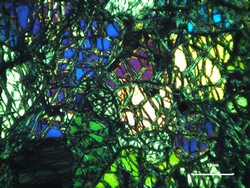Using nanoscale ophiolitic rocks to capture and sequester CO2
Remnants of ancient oceanic crust and upper mantle, ophiolites have been uplifted by tectonic activity and thrust onto the edge of continents and/or incorporated into mountain belts. CO2NOR (Carbon dioxide storage in nanomaterials based on ophiolitic rocks and utilization of the end-product carbonates in the building industry) specifically focuses on ophiolitic rocks from Cyprus’ Troodos Mountains — the country’s largest mountain range. ‘The Troodos ophiolite is the most intact worldwide,’ says Dr Ioannis Rigopoulos, Postdoctoral fellow at the University of Cyprus. ‘It is the closest thing we have to a complete ophiolite sequence which consists, from bottom to top, of a clearly defined sequence including ultramafic, mafic, hypabyssal and extrusive rocks.’ This sequence is typically what makes ophiolitic rocks particularly attractive for CO2 capture and storage, as Dr Rigopoulos explains: ‘The reactions between these rocks and CO2 create carbonate minerals (mineral carbonation), which are stable over geologic timescales. Hence, sequestration by mineral carbonation eliminates any risk of leakage back to the atmosphere. Additionally, the global abundance and low cost of ophiolitic lithologies are crucial parameters, taking into account that we need these rocks to mitigate the global problem of climate change.’ To do so, CO2NOR converts ultramafic and mafic ophiolitic rocks into nanomaterials using the ball milling process — a grinding technique used to turn a material into ultrafine powder. By applying this technique to reduce the particle size of ophiolitic rocks to the nanoscale, Dr Rigopoulos and his team aimed to hasten the reactions occurring between ultramafic/mafic rocks and CO2, more specifically the natural process that controls atmospheric CO2 concentrations over geologic timescales. ‘Our results clearly show that we can substantially increase the carbon sequestration capacity of ultramafic and mafic rocks by reducing their particle size to the nanoscale,’ Dr Rigopoulos says. ‘The fact that large volumes of ophiolites occur on almost every continent makes us believe that a significant mass of the CO2 emitted to the atmosphere every year could be sequestered using the proposed CCS method.’ The University of Cyprus also conducted experiments on waste materials from quarries operating in the Troodos ophiolite in order to highlight the sustainability of the process. ‘So far, we have performed more than 100 ball milling experiments in a variety of rocks/waste materials, and we have determined the optimum ball milling conditions for each one. The experimental results demonstrated that even ball-milled waste materials from ophiolitic quarries could be used as a feedstock for the ex situ mineralisation of CO2,’ Dr Rigopoulos explains. From next-gen building materials to geoengineering The nanomaterials resulting from the process were successfully used in the production of environmentally-friendly, nano-modified building materials. These composite materials, lime-based mortars, enriched with nanostructured quarry waste materials, present enhanced engineering properties and a potential capacity to sequester CO2, which Dr Rigopoulos hopes will appeal to the construction industry — one of the biggest emitters of CO2. The nanostructured quarry wastes can be used to replace lime binder, the production of which is responsible for a substantial part of these emissions. But Dr Rigopoulos and his team do not plan to stop there. ‘Together with our collaborators at the National Centre for Scientific Research — CNRS (France), we designed a number of experiments related to the new field of geoengineering or climate engineering, which is the large-scale human intervention in the Earth’s natural systems to counteract climate change. The results of these experiments were very promising.’ Specifically, the team assessed the potential drawdown of CO2 directly from the atmosphere by the enhanced weathering of nanoscale peridotites and basalts in seawater. The results demonstrated that ball milling can substantially enhance the weathering rate of peridotites in marine environments, promoting the permanent storage of CO2 as environmentally benign carbonate minerals. ‘It is worth mentioning that this enhanced weathering process removes carbon directly from the atmosphere, providing capture and storage in a single step. In this approach, the CO2 storage reservoir is the ocean, which covers over 70 % of the Earth’s surface. In addition, the enhanced weathering of nanoscale peridotites in seawater may also avert ocean acidification, which has drastic consequences for marine ecosystems,’ Dr Rigopoulos points out. In the future, the University of Cyprus hopes to build upon this research and improve its understanding of nanoscale rock materials. This entails further investigation into the efficiency of the proposed CCS approach over the longer term and, for geoengineering, emphasis on its effects on marine life.
Keywords
CO2NOR, ophiolites, ball milling, nanomaterials, CCS, ophiolitic rocks, Troodos mountains, ultramafic, mafic, CO2, carbon sequestration, quarry waste, construction industry, climate engineering, geoengineering, peridotites, marine life







